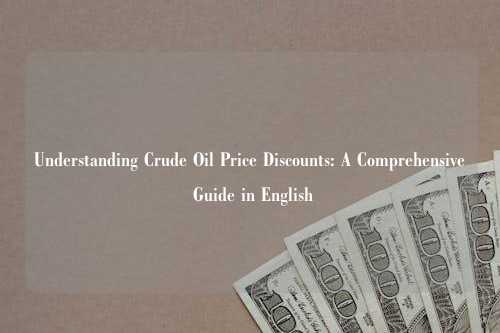Understanding Crude Oil Price Discounts: A Comprehensive Guide in English
When it comes to the global oil market, understanding the nuances of pricing is crucial for anyone involved in the industry. One term that often comes up is crude oil price discounts, or as it's sometimes referred to in English, "crude oil price discounts." But what exactly does this mean, and why is it important? Let's dive into the details.
What Are Crude Oil Price Discounts?
Crude oil price discounts refer to the reduction in the price of crude oil from its standard market rate. This can happen for a variety of reasons, such as oversupply, lower demand, or specific contractual agreements between buyers and sellers. Essentially, it's a way for sellers to make their product more attractive in a competitive market.

Why Do Crude Oil Prices Fluctuate?
The price of crude oil is influenced by a multitude of factors, including geopolitical events, supply chain disruptions, and changes in global demand. When these factors lead to an oversupply, sellers may offer discounts to encourage purchases. Conversely, when demand outstrips supply, prices can rise sharply.
How Are Crude Oil Price Discounts Calculated?
Calculating crude oil price discounts involves comparing the discounted price to a benchmark price, such as Brent Crude or West Texas Intermediate (WTI). The discount is usually expressed as a percentage or a fixed amount per barrel. For example, if the benchmark price is $70 per barrel and the discounted price is $65, the discount would be $5 per barrel or approximately 7.14%.
Real-World Examples of Crude Oil Price Discounts
One notable example occurred in 2020 when the COVID-19 pandemic led to a dramatic drop in global oil demand. As a result, many oil producers offered significant discounts to offload their excess supply. Another example is the discounts offered by OPEC countries to maintain market share in the face of competition from U.S. shale oil producers.
What Does This Mean for Consumers and Businesses?
For consumers, lower crude oil prices can translate to cheaper gasoline and heating oil. For businesses, particularly those in the transportation and manufacturing sectors, it can mean lower operating costs. However, it's essential to consider the broader economic implications, as prolonged low oil prices can negatively impact oil-producing countries and lead to job losses in the industry.
Frequently Asked Questions
- Q: How long do crude oil price discounts typically last?
- Q: Are crude oil price discounts a good thing?
- Q: Can I predict when crude oil prices will be discounted?
A: The duration of crude oil price discounts can vary widely depending on market conditions. They can last anywhere from a few weeks to several months.
A: It depends on your perspective. For buyers, discounts can be beneficial as they reduce costs. For sellers, however, prolonged discounts can erode profit margins and impact financial stability.
A: While it's challenging to predict exact timing, keeping an eye on market trends, geopolitical events, and supply-demand dynamics can provide valuable insights.
Conclusion
Understanding crude oil price discounts is essential for anyone involved in the oil industry or affected by oil prices. By grasping the factors that influence these discounts and how they are calculated, you can make more informed decisions, whether you're a consumer, business owner, or investor. Keep an eye on market trends and stay informed to navigate the ever-changing landscape of crude oil pricing.
